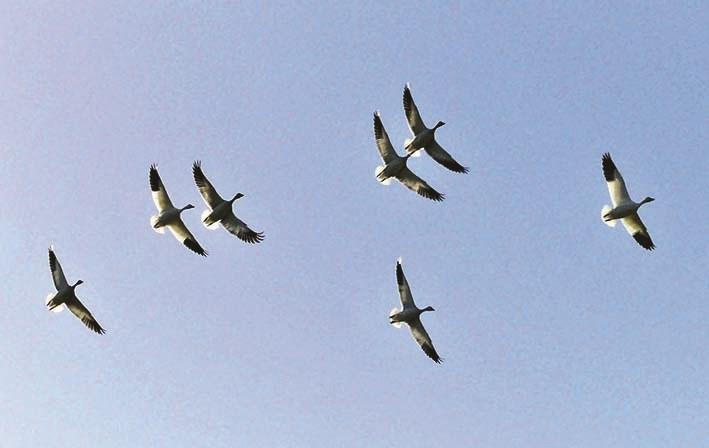To even the casual observer, nature seems to really come alive in April, as bird song is omnipresent, and the geese are flying noisily overhead. The goose migration peaked on the 19/20th with observers reporting thousands of birds overhead in multiple flocks. I live on Redrooffs Road in Halfmoon Bay, and on the 19th I heard fifteen separate flocks, and I wasn’t paying attention much of the time. Most of the flocks were flying high, offshore, roughly over Thormanby Island. A few days previously, the Sunshine Coast Natural History Society ran a field trip to the Reifel Refuge in Delta, where we observed flocks of (mainly) snow geese foraging on the Fraser River foreshore, prior to making their next long northward migration flight. The whole population of western snow geese, numbering over 100,000 birds, nests on Wrangel Island in Siberia, so they still have a long way to go from here.
Five species of goose fly over the Sunshine Coast, with snow geese the most numerous. The snow flocks are readily identified visually by their white bodies with black wingtips. Canada geese, cackling geese and greater white-fronted geese are more difficult to identify visually, though cackling are just a significantly smaller version of Canadas. With practice, or also with the help of the Merlin bird app, the species can be identified by their vocalizations. The fifth goose species is brant, which is not commonly reported from the Sunshine Coast. This is surprising, as thousands of brant congregate in the Parksville area across the Strait from us. The attraction of the Parksville area is the presence of extensive eel grass beds, which we lack on the Sunshine Coast. When brant are observed within the confines of the Sunshine Coast checklist area, they are usually flying low over the Strait.
All of these geese will next be seen flying southward in October. We wish them a successful breeding season in their Arctic summer homes.
On land, many of our summer breeding species have now arrived, with about 20 species still to appear (at April 22). Species that arrive in late April and through May include five species of flycatchers, some wood-warblers, plus vireos, swifts, western tanager, black-headed grosbeak, Swainson’s thrush, house wren and common nighthawk. The nighthawk is usually the last to arrive, often in the last two days of May, after a long migration flight from the Amazon. Birders are always anxious to find and report the first of the species for the year (referred to as FOY) and these reports are often posted at groups.io/g/sunshinecoastbirding. All are welcome to join this site and can post items of bird interest.
2025 has been a poor year so far for rarities. May has often produced rare birds in the past, so we live in hope!
To report your sightings or questions contact me at [email protected] or 604-885-5539. Good spring birding.



